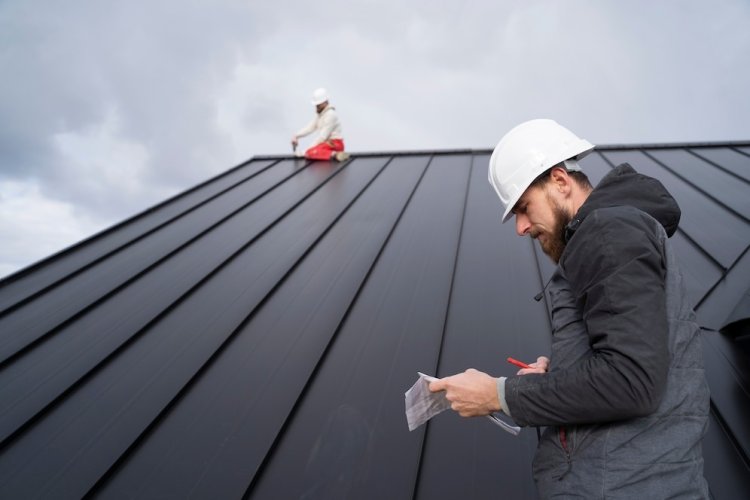Exposing the Common Myths About Commercial Roof Coatings
Many believe roof coating is just a quick fix. Explore the truth behind common myths and learn how roof coating can protect commercial buildings for years.

Common Myths About Commercial Roof Coatings
Roof coatings are an essential part of maintaining a commercial building’s roofing system. These coatings are designed to provide protection, extend the lifespan of the roof, and reduce maintenance expenses. However, despite their proven advantages, there are several myths about roof coatings that may deter building owners from considering them for their commercial properties.
In this post, we’ll address and debunk some of the most common myths surrounding roof coatings, offering clarity on how these systems can benefit your building and provide long-term value.
Myth 1: Roof Coatings Are Only for New Roofs
One of the most common misconceptions is that roof coating is only applicable to new roofs. Many people believe that a roof coating is a protective layer that should only be applied during the initial construction of a roof.
Reality: Roof coatings are ideal for both new and existing roofs. For older roofs, a roof coating can be a cost-effective solution to restore the surface and add years of life to the roofing system. Rather than replacing a roof that is showing signs of wear, a coating can act as a protective barrier against UV rays, water, and other environmental factors. Applying a roof coating to an aging roof can often prevent the need for a costly roof replacement.
Myth 2: Roof Coatings Are Only Effective in Certain Climates
Some people think that roof coatings are only beneficial in specific climates, particularly in hot, sunny areas where UV protection is crucial.
Reality: Roof coatings offer benefits in a wide variety of climates. While they are indeed effective at reflecting UV rays in warmer climates, they are also beneficial in colder areas. In cold climates, roof coatings help reduce the impact of freeze-thaw cycles, which can lead to roof damage. Coatings also prevent moisture from penetrating the roof, helping to avoid ice dam formation and reducing the risk of leaks.
In addition, many modern roof coatings are designed to adapt to extreme weather conditions, including heavy rain, snow, and high winds, making them suitable for nearly any geographic location.
Myth 3: Roof Coatings Are Too Expensive
Many business owners mistakenly believe that applying a roof coating is a costly endeavor, especially compared to the price of a roof replacement or repair.
Reality: In the long run, roof coatings are much more affordable than full roof replacements. While the upfront cost of a roof coating may seem higher than traditional maintenance methods, the cost savings over time are substantial. Roof coatings reduce the frequency of roof repairs, lower energy bills by improving the building’s insulation, and extend the life of the roof, delaying the need for a costly roof replacement.
Furthermore, many roof coatings come with warranties that can last for several years, providing peace of mind that your roof is protected for the long term.
Myth 4: Roof Coatings Can Be Applied by Anyone
There is a common belief that roof coatings are easy to apply and that anyone can handle the job, from the building owner to a general contractor without specialized knowledge.
Reality: While applying a roof coating may seem like a simple task, it requires specialized knowledge and skills. Proper surface preparation is essential for the coating to adhere correctly and provide the expected benefits. If the roof is not adequately cleaned, primed, or repaired before applying the coating, it may not bond effectively, leading to premature failure.
For the best results, it is important to hire experienced professionals who understand the complexities of the coating application process. These professionals will confirm the roof is prepped properly and that the coating is applied uniformly to achieve maximum protection.
Myth 5: Roof Coatings Are Only Cosmetic
Some people believe that the primary purpose of a roof coating is to improve the aesthetic appearance of the roof rather than provide practical benefits.
Reality: While roof coatings can improve the appearance of a roof, their main purpose is to provide functional benefits. The primary role of a roof coating is to protect the roof from the elements, prevent leaks, and extend the lifespan of the roofing system. Coatings form a waterproof barrier that keeps out moisture, which is essential for preventing roof damage caused by rain or snow.
Additionally, many coatings are designed to increase energy efficiency by reflecting sunlight and reducing heat absorption. This results in lower cooling costs and improved comfort inside the building.
Myth 6: Roof Coatings Are Only for Flat Roofs
Another myth that many people believe is that roof coatings are only effective on flat roofs, which are more common in commercial buildings.
Reality: Roof coatings can be used on both flat and sloped roofs. While flat roofs are more commonly coated due to their increased vulnerability to water accumulation, sloped roofs can also benefit from roof coatings. For sloped roofs, coatings can help to prevent leaks at vulnerable points such as seams and joints, protect against UV damage, and extend the roof’s lifespan.
A roof coating can also improve the performance of both types of roofs by providing an added layer of protection from the elements and reducing the need for frequent maintenance.
Myth 7: Roof Coatings Are a Temporary Solution
Some business owners may think that a roof coating is just a short-term fix that won’t provide lasting protection for their roof.
Reality: Roof coatings are designed to be a long-term solution when applied correctly. High-quality coatings can last for many years, providing sustained protection for the roof. The lifespan of the coating depends on factors such as the type of coating used, the application process, and the climate conditions in the area.
Many roof coatings come with warranties that guarantee their performance for up to 10-20 years, proving that they are a reliable and lasting investment. Regular maintenance and reapplication as needed can help confirm that the roof remains protected for decades.
Myth 8: Roof Coatings Don’t Work on All Roof Types
There is a misconception that roof coatings only work on specific types of roofing materials, such as asphalt or rubber roofs, and are not effective on other surfaces.
Reality: Roof coatings can be applied to a wide range of roofing materials, including metal, modified bitumen, built-up roofing (BUR), and single-ply membranes. The type of coating used will vary depending on the roof’s material, but the application of a roof coating can improve the roof’s performance, regardless of the material.
For example, metal roofs can benefit from coatings that prevent rust and corrosion, while EPDM (rubber) roofs may require a coating that improves UV protection. By choosing the right type of coating for your roof, you can enjoy the benefits of improved durability and protection.
Conclusion: The Truth About Roof Coatings
Roof coatings offer a range of benefits for commercial buildings, from extending the lifespan of the roof to improving energy efficiency and reducing maintenance expenses. By addressing the myths and misconceptions surrounding roof coatings, business owners can make informed decisions about protecting their roofs and confirming the long-term value of their buildings.
It’s important to choose the right roof coating for your specific needs and to work with a professional contractor who has the experience and expertise to apply the coating correctly. By doing so, you can enjoy the full benefits of a well-maintained roof and avoid the costly repairs or replacements that may arise from neglecting your roofing system.
What's Your Reaction?















.jpg)
